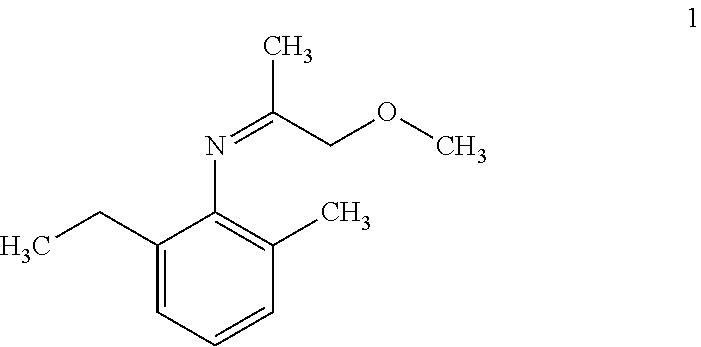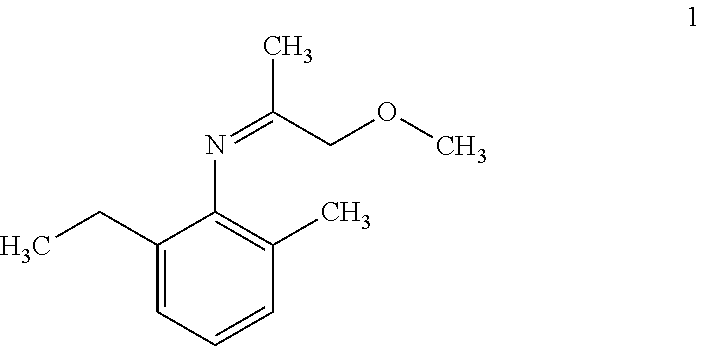Hydrogenation of imines
a technology of imines and hydrogenated imines, which is applied in the field of asymmetric hydrogenation of imines, can solve problems such as difficult to meet, problems such as the purity of products, and the problem of re-using homogeneous catalysts, and achieve high conversion efficiency and high enantiomeric excess
- Summary
- Abstract
- Description
- Claims
- Application Information
AI Technical Summary
Benefits of technology
Problems solved by technology
Method used
Image
Examples
example 1
i) Hydrogenation of 2-ethyl-N-(1-methoxypropan-2-ylidene)-6-methylaniline using ligand [(1R,2R,3S)-1,2-dimethyl-2,3-bis(diphenyl phosphinomethyl)cyclopentyl)methanol (1) in presence of different additives.
[0064]0.001 mmol of ligand, [(1R,2R,3S)-1,2-dimethyl-2,3-bis(diphenyl phosphinomethyl)cyclopentyl]methanol, (I), 0.0005 mmol of [Ir(COD)Cl]2 and 0.004 mmol of the corresponding additive were mixed together under argon in 0.1 ml dichloromethane and the mixture was stirred at room temperature for 20 min. Meanwhile 0.1-5 mmol solution of the substrate in the corresponding solvent was introduced to the autoclave. The catalyst solution was then introduced to the autoclave and the autoclave was purged with hydrogen at an elevated pressure. The reaction mixture was warmed under in oil bath to the desired elevated temperature. After cooling and release of pressure, a sample of the reaction mixture was withdrawn from the autoclave. The solvent was evaporated and residue was dissolved in 200...
example 2
Hydrogenation of 2-ethyl-N-(1-methoxypropan-2-ylidene)-6-methylaniline using Different Ligands
[0068]The experimental procedure of Example I above was followed for the different ligands of present invention. The results for the final product for conversion (%) and ee (%) using different additives and different solvents are tabulated in the accompanying Table 2 wherein ligands and additives are as described before.
TABLE 2Sr.ConversioneeAbs.No.LigandSolventAdditive(%)(%)conf.1.ITolueneB10080S2.I1,4-dioxaneB9977S3.III1,4-dioxaneH10076S4.VI1,4-dioxaneA10076S5.VI1,4-dioxaneH10076S
[0069]The results in Table 2 substantiate that the process of the present invention provides high conversion efficiency for the hydrogenation of imines, even in absence of any acid, such that the process enables at least 99% to 100% conversion of the starting material to the target product having >76% enantiomeric excess of the target product.
example 3
Hydrogenation of 2-ethyl-N-(1-methoxypropan-2-ylidene)-6-methylaniline using ligand (S)-2-[(o-diphenylphosphino)-phenyl]-1-diphenylphosphino-ferrocene (IV)
[0070]0.001 mmol of ligand (IV), 0.0005 mmol of [Ir(COD)Cl]2 and 0.004 mmol of additive A were mixed together under argon in 0.1 ml dichloromethane and the mixture was stirred at room temperature for 20 min. Meanwhile 0.1 mmol solution of 2-ethyl-N-(1-methoxypropan-2-ylidene)-6-methylaniline in dichloromethane was introduced to autoclave. Eventually 0.12 ml of acetic acid was added in the autoclave and the autoclave was purged with hydrogen and pressurized to 50 bar. The reaction mixture was warmed under stirring in an oil bath to 50° C. and reaction continued for 18 hr. Reaction mixture was cooled down and after pressure had been released, the final product of reaction mixture was withdrawn from autoclave, solvent was evaporated and the residue was dissolved in 200 μl isopropanol and 1 ml hexane and the whole was filtered through...
PUM
| Property | Measurement | Unit |
|---|---|---|
| temperature | aaaaa | aaaaa |
| temperature | aaaaa | aaaaa |
| hydrogen pressure | aaaaa | aaaaa |
Abstract
Description
Claims
Application Information
 Login to View More
Login to View More - R&D
- Intellectual Property
- Life Sciences
- Materials
- Tech Scout
- Unparalleled Data Quality
- Higher Quality Content
- 60% Fewer Hallucinations
Browse by: Latest US Patents, China's latest patents, Technical Efficacy Thesaurus, Application Domain, Technology Topic, Popular Technical Reports.
© 2025 PatSnap. All rights reserved.Legal|Privacy policy|Modern Slavery Act Transparency Statement|Sitemap|About US| Contact US: help@patsnap.com



